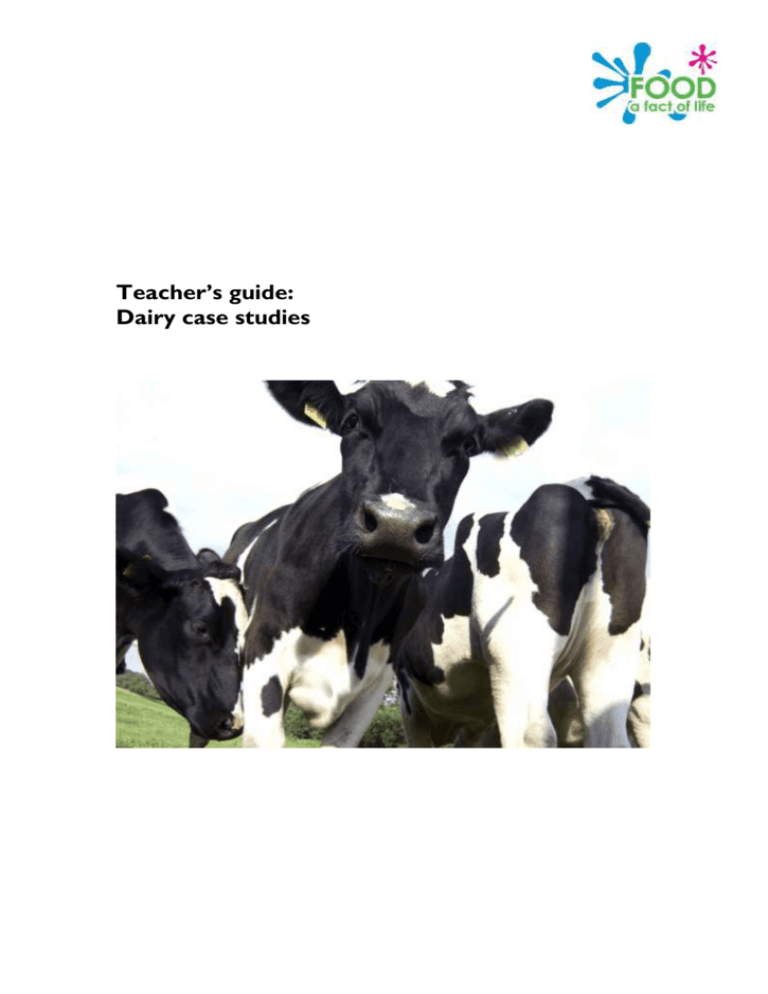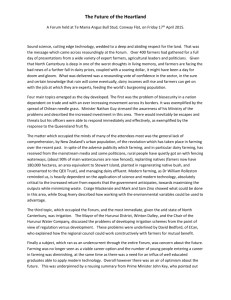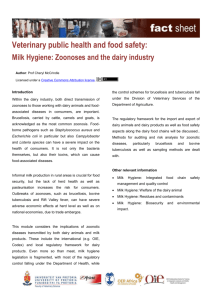Teachers guide - Food a fact of life
advertisement

Teacher’s guide: Dairy case studies Welcome This guide will help you plan a series of successful lessons, exploring dairy farming and the production and processing of dairy foods, for students aged 11-16 years. The resources have been developed to be flexible to suit your teaching needs, feel free to ‘dip-in’ and select those most relevant to your lessons. These resources support a wide range of curriculum areas, including science, food technology, home economics, geography, health and wellbeing, and personal, social and health education. The case study format provides students and teachers with up-to-date, accurate and consistent messages. The dairy industry The dairy industry makes a major contribution to the British diet. Around 5 billion litres of milk are sold in Britain each year and we consume an average of 1.6 litres each a week. On top of that, 7 billion litres go into dairy products such as cheese, butter and dried milk powder, which is a vital component of many other food products. (Source: thisisdairyfarming.com) It is important to be aware of where our food comes from and how the animals and natural resources are treated that provides that food. The dairy industry maintains high standards of animal health and welfare on farms and actively seeks to sustain the environment. These case studies have been developed to support teachers and student investigating this area of food production and processing. The key topics include: 1. Animal health and welfare 2. The environment and sustainability 3. Diversity of farming systems 4. Production of milk (and other dairy products, e.g. cheese) The resources The resources comprise: 5 x PowerPoint presentations (these can be modified allowing you to tailor these to suit the needs of your students) Introduction to dairy farming The environment and sustainability Health and welfare of cows Diversity of farming systems Dairy farming case study 4 x photocopiable note sheets: these can be used to guide your students in note taking and creating summaries of the information presented in the PowerPoint presentations; 4 x photocopiable worksheets, based on the information provided in the PowerPoint presentations. 3 x photocopiable data sheets: these provide data on the nutritional composition of milk, yogurt and cheese; 2 x online tutorials: each allows independent, self-paced, differentiated, learning experiences using online information and activity slides with the facility to print a report at the end. © Food – a fact of life 2011 2 Classroom activities There are many opportunities where information on dairy farming and food processing can form part of a lesson or scheme of work. Here are a variety of ideas to get you started: Each PowerPoint presentation can be used in conjunction with the note sheet as part of a lesson with the whole class. Alternatively, students who finish work early or who wish to work independently can also complete the note sheets on their own. The online tutorials can be used for extension work or assigned as homework. A farm visit could be arranged, with the resources either being used to prepare students for the visit or after the visit to consolidate student learning. Alternatively, information concerning farming could be researched online or experts could be accessed for presentations in school. Students could also: Investigate the different farming systems and set up a debate between two different systems, such as organic vs. non-organic, or extensive farming vs. all-year-round housing. Research a variety of food products, such as Cheddar cheese, which are legally permitted to use the Protected Designation of Origin (PDO) mark on labelling. Explore the different schemes set up to help protect the health and welfare of dairy cows, and promote sustainability. Create a list of the different employment opportunities and the skills needed to work on a dairy farm. © Food – a fact of life 2011 3 Links the to UK Curricula This chart shows the main curricula links to different subjects throughout the UK. There are also lots of other opportunities in school for cross-curriculum links, including geography, history, art and design, health education, numeracy and literacy. Food – a fact of life also supports the appropriate use of ICT. Country England Northern Ireland Scotland Wales Opportunities for use of these resources Key stage 3 Design and technology Range: Design d. the impact of products beyond meeting their original purpose and how to assess products in terms of sustainability. Key Stage 3: Science Range 3.4.c human activity and natural processes can lead to changes in the environment. Key Stage 3: Citizenship Range e. actions that individuals, groups and organisations can take to influence decisions affecting communities and the environment Key stage 4: Design and technology and home economics courses Examination specifications contain references to the food chain, consumer responsibility and sustainability. Materials within this resource can be used to help support teaching on these areas. Key stage 3 Life, learning and work: Home economics Although not specifically mentioned, aspects of the food chain and sustainability are important attributes of Home Economics. Key stage 3: Environment and society - Geography Objective 3. Developing pupils as contributors to the economy and environment Key stage 4: Design and technology and home economics courses Examination specifications contain references to the food chain, consumer responsibility and sustainability. Materials within this resource can be used to help support teaching on these areas. Second and third Health and wellbeing: Food and the consumer HWB 3-36a Technologies: Technological developments in society TCH 3-02a Fourth Health and wellbeing: Nutrition HWB 4-30a Health and wellbeing: Food and the consumer HWB 4-36a Technologies: Technological developments in society TCH 4-01a / TCH 401c Key stage 3 : Science: The sustainable earth - range 5 Key stage 3 : Science: How things work – range 6 Key Stage 4: Science Environment, earth and universe range Range: The effects of human activity on the environment using living and nonliving indicators. Key stage 4: Design and technology and home economics courses Examination specifications contain references to the food chain, consumer responsibility and sustainability. Materials within this resource can be used to help support teaching on these areas. © Food – a fact of life 2011 4 Links to the Food Standards Agency’s Food Competences for young people The Food Competences for young people can help young people to choose, cook and eat safe healthy food. These competences are set out as a framework of core skills and knowledge for children and young people. The food competences support wider UK Government work aimed at improving the health of young people and will contribute towards helping schools develop a 'whole school approach' to diet and health. Diet and health By the age of 14, pupils should: • use current healthy eating advice to choose a varied balanced diet for their needs, as well as being physically active. • know that food provides energy and nutrients in different amounts; that they have important functions in the body; and that people require different amounts during their life, e.g. pregnancy, infant feeding. • be able to apply current healthy eating recommendations, and understanding of peoples' needs, to their own diet and others', e.g. before and during pregnancy. By the age of 16+, students should: Consumer awareness By the age of 14, pupils should: • know that food is produced, processed and sold in different ways, e.g. conventional and organic farming, fair trade. • consider a wider range of factors when making food choices, e.g. seasonality, local food, sustainability. By the age of 16+, students should: Food safety By the age of 14, pupils should: • understand the principles of cleaning, preventing cross-contamination, chilling, cooking food thoroughly and reheating food until it is piping hot. © Food – a fact of life 2011 5 Sources of further information British Nutrition Foundation www.nutrition.org.uk Dairy Council – www.milk.co.uk DairyCo www.dairyco.org.uk Farm for schools – www.farmforschools.org.uk Farming and Countryside Education www.face-online.org.uk Food – a fact of life www.foodafactoflife.org.uk Red Tractor www.redtractor.org.uk Royal Highland Education Trust www.rhet.org.uk School milk - www.schoolmilk.co.uk This is dairy farming www.thisisdairyfarming.co.uk Acknowledgement This work has been developed by the British Nutrition Foundation, and is supported by the Agriculture and Horticulture Development Board's (AHDB) milk sector organisation DairyCo. © Food – a fact of life 2011 6





